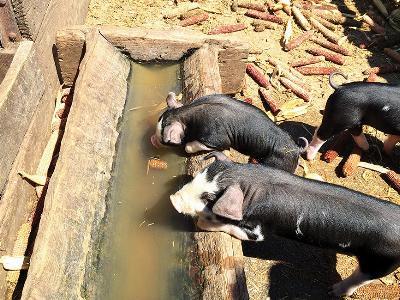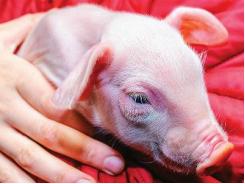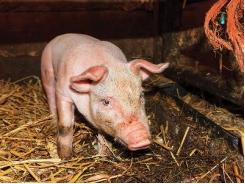10 practical piglet gruel feeding guidelines

Piglets will instinctively investigate any moist-liquid material within their reach, making gruel feeding a natural feeding method. | Noah Browning, Dreamstime.com
A feeding method recommended for underprivileged piglets that requires attention to details but pays dividends in speeding up the growth of small-for-age weaners
Gruel feeding is a management practice that targets the bottom 10 to 20 percent of small-for-age piglets in any weaning group, regardless of weaning age. Of course, the greater the weaning age, the fewer the pigs that require or rather benefit from gruel feeding. In general, research and commercial experiences have indicated that gruel feeding offers four distinct advantages when done correctly:
- Enhances ingestion of nutrients, especially during the early days post-weaning
- Allows a smoother transition to dry feed, especially when the feed is pelleted
- Prevents damage of the gut due to soybeans or prolonged starvation
- Promotes hydration, an extra and very significant benefit, particularly in sick piglets
Of course, for all these to succeed, gruel feeding needs to be done according to high(er) standards of hygiene. It is usually a labor-intensive task and requires staff dedicated to assisting underprivileged piglets. Below is a 10-step guideline for efficient and practical gruel feeding.
- Use large, open bowls or lock-down circular feeders. In general, the larger plastic feeders offer the best results as they allow communal feeding.
- Place the gruel feeder near the feeder with the dry feed, avoiding pen corners, waterers, sleeping mats and heat lamps.
- Place a small amount of dry feed in the normal feeders from the first day, even though piglets may appear to ignore it. Use the same formula/product as that used in mixing the gruel.
- A strong flavor with a distinct aroma in the product used in mixing the gruel and in the dry feed is believed to help piglets associate dry feed with nourishment.
- Offer gruel at least three times per day, starting with a mix of 1/4 dry feed and 3/4 water in a large bucket for all pigs or directly in each feeder.
- Using warm water or liquid milk replacer may also be used to create a gruel. In fact, the latter is believed to promote even higher intake, but this might not be needed if the dry feed is already high in dairy products.
- Feed enough gruel for pigs to clean up in a single feeding episode. If gruel is left uneaten, remove it, clean the feeders and reduce allowance in the following feeding.
- Gradually thicken the gruel to 2/3 pellets or meal and 1/3 water. This will allow piglets to turn to dry feed easier and faster.
- Gradually reduce the number of feedings per day and discontinue by day four or five after weaning. Again, this is done to convince piglets to convert to dry feed. The exact timing should be determined by the people who actually do the feeding because they can determine when each pen no longer requires gruel to thrive.
- Make sure pigs have access to fresh water from day one from drinkers. For underprivileged piglets, a bowl-type drinker is believed to give better results, whereas some prefer to use nipple water drinkers that allow to dribble during the first day or so.
Typical five-day program for feeding gruel to fall-back pigs
The table provides an example of a commercial gruel feeding program. It is not the only schedule possible, but it is one that provides good results in most farms. Usually, gruel feeding is discontinued by the third day post-weaning, although in pens with sick pigs it might be extended to seven days or longer.

An example of a commercial gruel feeding program that provides good results in most farms.
When pigs only drink the water and leave the feed
Sometimes, especially during the first couple of days of gruel feeding, pigs may drink only the liquid (water) and leave a paste of feed at the bottom of the feeder. This indicates the pigs are particularly thirsty, and an alternative way of providing water must be provided. Replenishing the feeder with more water usually results in consumption of the remaining feed.
Avoid a second weaning
One of the most discussed problems of gruel feed is that piglets love gruel too much. In fact, they like it so much that if they can have enough of it, they will not consume dry feed. So, it is important to offer them just enough gruel to sustain them without satisfying their hunger. This will force them to seek more nutrients from normal (dry) feed. It is important to reiterate that this dry feed should be the exact same product used to mix the gruel. In addition, a gradual change from gruel-supplemented nutrition to all-dry feed is recommended. Such a program is presented in the table, which can be adapted according to requirements.
Is there an ideal product for gruel mixing?
There are some dry products (powders) that are sold to be used in gruel. Most of them are very similar to a milk powder replacer, which does serve the purpose of gruel feed: forcing piglets to consume dry feed within the medium of the “soup.” A liquid milk replacer has a different role. In general, it is considered best to use the creep feed (offered during the lactation period) or the first diet post-weaning (sometimes these two can be the same). It is not a bad idea to buy a diet of higher quality to be used as gruel for underprivileged piglets than that used in the rest of the weaning group. The extra expense, if associated with higher quality, usually pays back dividends by speeding up these small-for-age pigs to reach the performance of their heavier counterparts by the end of the nursery period.
Ioannis Mavromichalis, Ph.D., is Nutrition Editor for WATTAgNet and Editor-in-Chief of Pig International.
Related news
Tools

Phối trộn thức ăn chăn nuôi

Pha dung dịch thủy canh

Định mức cho tôm ăn

Phối trộn phân bón NPK

Xác định tỷ lệ tôm sống

Chuyển đổi đơn vị phân bón

Xác định công suất sục khí

Chuyển đổi đơn vị tôm

Tính diện tích nhà kính

Tính thể tích ao



 How piglet gastric pH development affects gut health
How piglet gastric pH development affects gut health  Coccidiosis in piglets remains a worldwide problem
Coccidiosis in piglets remains a worldwide problem